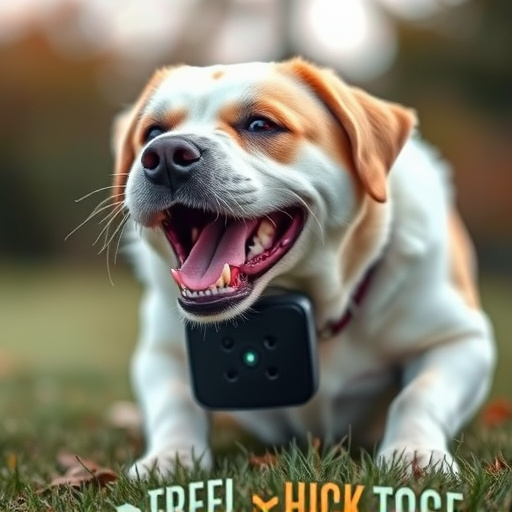Dogs communicate through barking, but excessive barking can be addressed with ultrasonic frequency devices that emit inaudible sounds. These tools allow owners to customize Bark Control Intensity Settings for humane training, encouraging positive reinforcement and modifying canine behavior over time. Ultrasonic trainers leverage dogs' exceptional hearing, safely and effectively communicating through high-frequency sound waves. By starting at low intensity and gradually increasing as dogs show calm behavior, handlers can ensure effective, trust-building training tailored to each dog's needs. Consistency, regular use, positive reinforcement, and diverse environment practice are key for optimal results in modifying excessive barking or other behaviors.
Unleash a peaceful environment with an innovative solution: the ultrasonic frequency dog behavior modification tool. This device tackles excessive barking by leveraging ultrasonic sound, tailored to sensitive canine hearing. Our guide navigates understanding dog behavior and introducing this technology. We delve into the science behind its effectiveness, offering tips for optimal results. Learn how to customize bark control intensity settings for a gradual, safe, and successful training experience.
- Understanding Dog Behavior and Barking Patterns
- Introduction to Ultrasonic Frequency Tools for Dog Training
- Customizing Bark Control Intensity Settings: A Gradual Approach
- The Science Behind Ultrasonic Sensitivity in Dogs
- Effective Use Cases and Tips for Optimal Results
Understanding Dog Behavior and Barking Patterns
Dogs communicate through a variety of vocalizations, with barking being one of their primary means. Understanding barking patterns is crucial when addressing dog behavior issues. Different barks can signal various emotions and needs—from excitement and attention-seeking to fear or anxiety. By customizing bark control intensity settings on ultrasonic frequency devices, owners can teach their dogs alternative behaviors without causing distress.
These tools emit high-frequency sounds that are inaudible to humans but can capture a dog’s attention, helping to reduce excessive barking. The ability to adjust the intensity allows for a tailored approach, ensuring the device is effective yet humane. This method encourages positive reinforcement training, where dogs learn desired behaviors by associating them with pleasant experiences, thereby modifying their actions over time.
Introduction to Ultrasonic Frequency Tools for Dog Training
Ultrasonic frequency tools have emerged as innovative solutions for dog behavior modification, offering a unique approach to training that’s both safe and effective. These devices utilize high-frequency sound waves, typically above the human hearing range, to communicate with dogs in a way they can understand and respond to. By emitting these ultrasonic tones, trainers can guide canine behavior without resorting to traditional methods that might cause discomfort or stress.
One of the key advantages is the ability to customize bark control intensity settings. These tools allow owners to adjust the frequency and volume of the sounds, ensuring a targeted response tailored to each dog’s sensitivity. This customization promotes effective training while minimizing potential harm. Moreover, ultrasonic trainers are particularly useful for addressing specific issues like excessive barking, jumping, or aggression, making them versatile aids in shaping desired canine behaviors.
Customizing Bark Control Intensity Settings: A Gradual Approach
When introducing an ultrasonic frequency dog behavior modification tool, customizing the Bark Control Intensity Settings is a crucial step for effective and safe training. Users should adopt a gradual approach, starting with the lowest intensity level to allow the dog to acclimate to the sound. This meticulous process ensures that the dog associates the ultrasonic signal with its behavior rather than experiencing discomfort or fear.
Gradually increasing the intensity level as the dog shows consistent calm behavior is key. It’s important to monitor the dog’s reaction closely and avoid pushing through if any signs of distress are observed. This methodical customization not only enhances the tool’s effectiveness but also builds a positive training environment, fostering trust between the dog and its handler.
The Science Behind Ultrasonic Sensitivity in Dogs
Dogs possess an incredible sense of hearing, far surpassing that of humans. This heightened sensitivity is due to their numerous auditory receptors and a specialized inner ear structure. Ultrasonic frequencies, often outside the human range of hearing, are within the dog’s natural perception. The science behind it lies in their ability to detect subtle vibrations and sound pressure changes.
When it comes to behavior modification, particularly for excessive barking, ultrasonic tools offer a unique approach. These devices emit high-frequency sounds that are inaudible to humans but can be tailored to specific dogs’ needs. By customizing the bark control intensity settings, owners can effectively train their dogs without causing discomfort or distress. This method allows for positive reinforcement, teaching canines appropriate behavior while ensuring their well-being.
Effective Use Cases and Tips for Optimal Results
When using an ultrasonic frequency dog behavior modification tool, it’s crucial to understand its versatility in addressing various canine behaviors. This technology is particularly effective for modifying excessive barking, providing a gentle yet powerful method to train your pet. By customizing the bark control intensity settings, you can tailor the device to your dog’s unique needs and sensitivity. Start with lower settings during initial training sessions, gradually increasing as your dog adapts and responds positively.
For optimal results, consistency is key. Ensure regular usage of the device according to your training schedule. Combine its use with positive reinforcement techniques, rewarding desired behaviors without barking. Regular practice in diverse environments further reinforces learning. Remember, patience is essential; behavior modification takes time, and individual dogs learn at different paces. Adjusting the settings and training methods accordingly will help foster a calm and well-behaved canine companion.
Ultrasonic frequency tools offer a non-invasive and effective method for modifying dog behavior, especially regarding barking. By understanding canine behavior patterns and customizing bark control intensity settings, owners can train their pets with positive reinforcement while minimizing stress. The science behind ultrasonic sensitivity in dogs ensures targeted communication without causing harm. With gradual adjustments and optimal use cases, these tools can revolutionize how we address unwanted behaviors, fostering happier and more harmonious relationships between pets and their owners.
